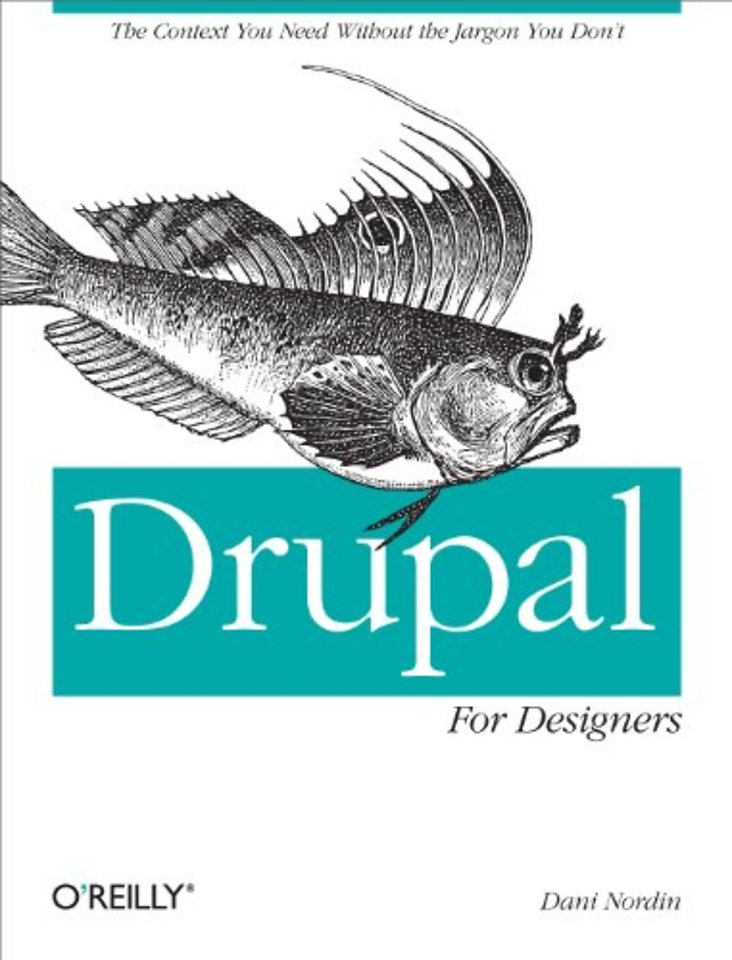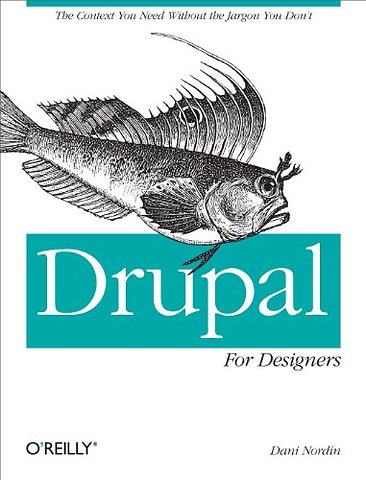Drupal for Designers
Samenvatting
Are you a solo web designer or part of a small team itching to build interesting projects with Drupal This hands-on book provides the tools and techniques to get you going. Award-winning designer Dani Nordin guides you through site planning, teaches you how to create solid, user-centered design for the Drupal framework, and shows you tricks for using real, honest-to-goodness, developer Ninja Magick.
This book is a compilation of three short guides—Planning Drupal Projects, Design and Prototyping for Drupal, and Drupal Development Tricks for Designers—plus exclusive "director’s material." If you’re familiar with HTML and CSS, but struggling with Drupal’s learning curve, this is the book you’ve been looking for.Get extra material, including an expanded Grids chapter, more recommended modules, and a Short Form Project planLearn how to work user-centered design practices into Drupal projectsChoose the right modules for your project, and discover several go-to modulesUse strategies for sketching, wireframing, and designing effective layoutsManage Drupal’s markup, including code generated by the powerful Views moduleLearn how to work with Drupal on the command lineSet up your development environment and collaborate with other designers and developersLearn the basics of Git, the free open source version control system
Specificaties
Inhoudsopgave
Introduction;
A Caveat;
Focus on Drupal 7;
About the Case Studies;
Conventions Used in This Book;
Using Code Examples;
Safari® Books Online;
How to Contact Us;
Acknowledgments;
About the Author;
About the Reviewers;
Chapter 1: Some Things to Remember About Working with Drupal;
1.1 A Quick and Dirty Guide to DrupalSpeak;
1.2 Discussing Drupal with Clients;
1.3 Organizing Your Files;
1.4 Life Cycle of a Drupal Project;
1.5 Implementation Plans: Breaking Up Your Work;
1.6 And Now We Are Six;
Discovery and User Experience;
Chapter 2: Setting the Stage—Discovery and User Experience;
2.1 Discovery: Breaking Down the Project Goals;
2.2 Project Discovery;
2.3 User Experience: Framing the Design Challenge;
2.4 Bringing UX Design to an Embedded Team;
2.5 The Drupal Designer’s UX and Design Toolkit;
Chapter 3: User Experience—Techniques for Drupal;
3.1 User Personas;
3.2 User Flows;
3.3 Mind Mapping;
3.4 Functional Breakdowns;
3.5 Screen Sketches and Wireframes;
3.6 Content Strategy Documents;
3.7 Low-Fidelity Prototypes;
3.8 Functional Specifications;
3.9 Paper Prototypes;
3.10 Non-HTML Digital Prototypes;
3.11 HTML or Drupal Prototypes;
3.12 UX Techniques and Drupal: Some Practical Issues;
3.13 A Further Note on Documents;
Chapter 4: Putting It in Practice—A Short-Form Project Brief;
4.1 Real-World Example: The TZK Project Plan;
4.2 Go Deeper: User Experience and Project Management;
Sketching, Visual Design, and Layout;
Chapter 5: Sketch Many, Show One;
5.1 Style Tiles: A Way to Explore Multiple Design Ideas;
5.2 Design Layout: Covering All Your Bases;
Chapter 6: Working with Layout Grids;
6.1 Why Use a Grid?;
6.2 Grids in Wireframing;
6.3 Grids in Theming;
6.4 Anatomy of a Grid Layout;
6.5 Working with Square Grid;
6.6 But What About All These Presentational Classes? There Must Be a Better Way!;
6.7 The New CSS Grid Layout Module: The Future Is Now;
6.8 Going Deeper: CSS Layout and Grid Systems;
Chapter 7: Putting It in Practice—Setting Up Fireworks Templates for Drupal;
7.1 Step 1: Set Up the Grid;
7.2 Step 2: Set Up the Header;
7.3 Step 3: Create a Single Node Page Without a Sidebar;
7.4 Step 4: Create Single Node Pages with One and Two Sidebars;
7.5 Step 5: Create the Other Pages;
Setting Up a Local Development Environment;
Chapter 8: The Drupal Designer’s Coding Toolkit;
8.1 Wait, What? Why?;
8.2 A Note for Windows Users;
8.3 The Drupal Designer’s Coding Toolkit;
8.4 Working on the Command Line: Some Basic Commands;
Chapter 9: Installing Drush;
9.1 Installing Drush;
9.2 Another Option: Creating a Symbolic Link to Drush;
9.3 Now the Fun Begins;
Chapter 10: Getting Started with Git;
10.1 Master Versus Origin;
10.2 Setting Up Git for Your Workflow;
10.3 Step 1: Create an SSH Key;
10.4 Step 2: Install Git;
10.5 Step 3: Set Up Your Git Configuration;
10.6 Step 4: Set Up a GitHub Account;
10.7 Step 5: Create the Remote Repository;
10.8 Step 6: Set Up the Local Repository;
10.9 So, What Happens on a Team?;
10.10 First Things First: The Git Workflow;
10.11 And There We Go;
Chapter 11: Putting It in Practice—Setting Up a Local Development Environment and Installing Drupal;
11.1 Step 1: Install MAMP;
11.2 Step 2: Set Up Your Local File Structure;
11.3 Step 3: Set Up the Drupal Files;
11.4 Step 4: Set Up the Drupal Database;
11.5 Step 5: Install Drupal;
11.6 Step 6: Use Drush to Install Some Modules;
Prototyping in Drupal;
Chapter 12: Prototyping in Drupal;
12.1 Working with Content and Content Types;
12.2 Trial by Fire;
12.3 Working with Content Types: A High-Level Overview;
12.4 Organizing Your Content;
12.5 Putting It All Together;
Chapter 13: Choosing Modules;
13.1 So Many Modules; How Do I Choose?;
13.2 Go-To Modules;
13.3 Oh-So-Nice-to-Have Modules;
13.4 I Don’t Need This, but Ooh, It’s Purty! Modules;
13.5 A Completely Incomplete Listing;
Chapter 14: Making Views Sing—Using Views to Enhance a Layout;
14.1 But I’m Not a Developer—What If I Don’t Want to Code?;
14.2 Step 1: Create the “Event Categories” Taxonomy Vocabulary;
14.3 Step 2: Create the Event Content Type;
14.4 Step 3: Create an Image Style;
14.5 Step 4: Create the User Profile;
14.6 Step 5: Get Profile Content into the Event Page;
14.7 Step 6: Set Up the Contextual Filter;
14.8 Step 7: Set Up the Related Events Block;
14.9 So, What Did We Just Do Here?;
Chapter 15: Making Views Sing—Controlling Views Markup;
15.1 Step 1: Associate an Image with a Taxonomy Term;
15.2 Step 2: Create the Event Categories View;
15.3 Step 3: Update the Field Settings;
15.4 Step 4: Add a Custom Class to Each Taxonomy Term: Name Field;
15.5 Step 5: Style Away;
15.6 So, What Did We Just Do Here?;
Chapter 16: Getting Started with Drupal Theming: Base and Child Themes;
16.1 Breaking Down a Layout for a Drupal Implementation;
16.2 Choosing a Base Theme;
16.3 Creating a Child Theme;
16.4 Other Things You Should Know About Base Themes;
16.5 Please, Tell Me More!;
Chapter 17: Making CSS Easier with LESS;
17.1 Creating Variables;
17.2 The Mighty Mixin;
17.3 Nested Selectors and Styles;
17.4 Compiling the Code;
17.5 Working with LESS: Organizing Your Stylesheets;
17.6 Why LESS Is Awesome (Besides the Obvious);
17.7 Working with LESS on a Team;
Making It Easier to Start Projects;
Chapter 18: Using Features;
18.1 Still More Awesomeness Awaits;
Chapter 19: Working with Drush Make and Installation Profiles;
19.1 Step 1: Install Drush Make;
Working with Clients;
Chapter 20: Proposing and Estimating Projects;
20.1 Preproposal Discovery: What You Need to Know;
20.2 Pricing a Project: Fixed-Bid Versus Hourly;
20.3 Writing the Proposal;
Chapter 21: Getting Clients to Love You, Even When You Have to Tell Them “No”;
21.1 That’s Easy for You to Say ...;
21.2 The “Professional Relationship” Clause;
Chapter 22: After the Handoff—The Project Retrospective;
22.1 Including Clients in the Retrospective;
22.2 Documenting What You Learned;
22.3 Documenting for the Community;
Sample Documents;
Project Brief;
Hey There! It’s Nice to Meet You.;
Work Agreement (with Professional Relationship Clause);
Work Agreement;
Terms and Conditions;
Payment Notes;
Additional Terms;
Project Proposal;
Project Proposal;
Section 1.0: Project Background and Objectives;
Section 2.0: Statement of Work;
Section 3.0: Development Process;
Section 4.0: Budget Estimate;
Section 5.0: The Zen Kitchen Background and Capabilities;
Section 6.0: Terms and Conditions;
Colophon;
Net verschenen
Rubrieken
- aanbestedingsrecht
- aansprakelijkheids- en verzekeringsrecht
- accountancy
- algemeen juridisch
- arbeidsrecht
- bank- en effectenrecht
- bestuursrecht
- bouwrecht
- burgerlijk recht en procesrecht
- europees-internationaal recht
- fiscaal recht
- gezondheidsrecht
- insolventierecht
- intellectuele eigendom en ict-recht
- management
- mens en maatschappij
- milieu- en omgevingsrecht
- notarieel recht
- ondernemingsrecht
- pensioenrecht
- personen- en familierecht
- sociale zekerheidsrecht
- staatsrecht
- strafrecht en criminologie
- vastgoed- en huurrecht
- vreemdelingenrecht

